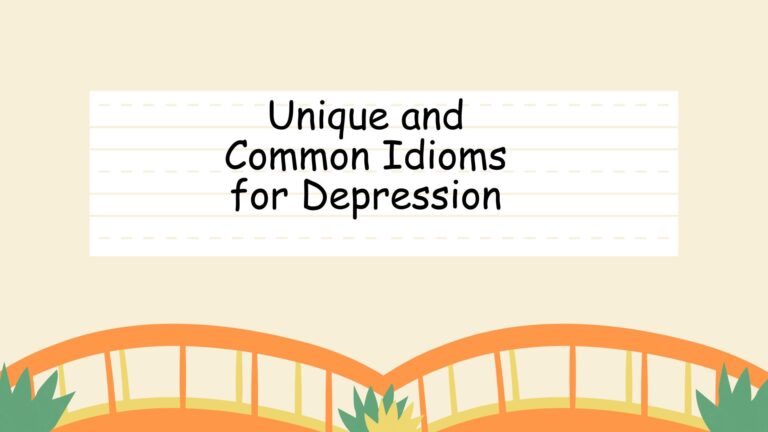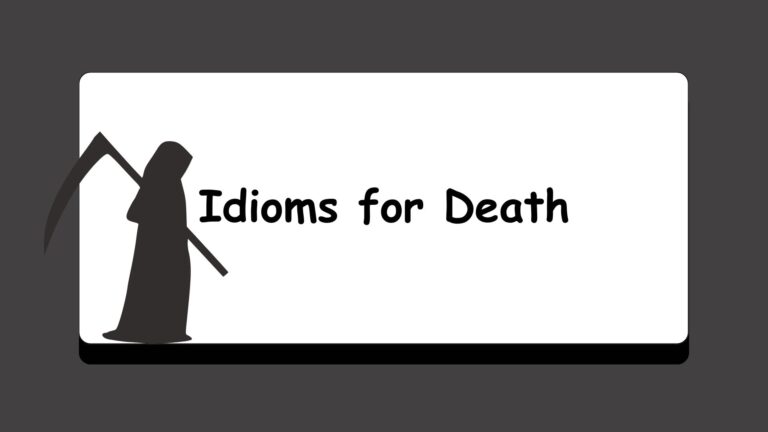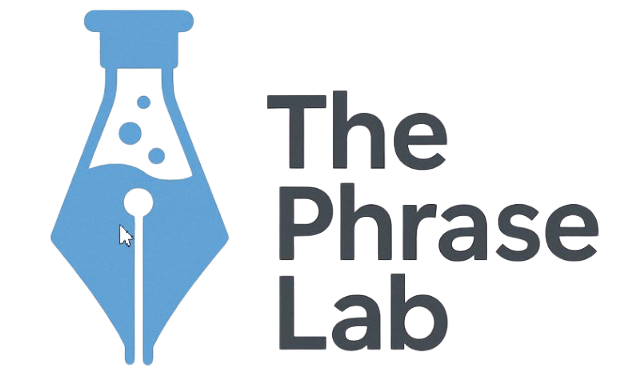
Beyond “Food” and “Drink”: Expanding Your Culinary Vocabulary
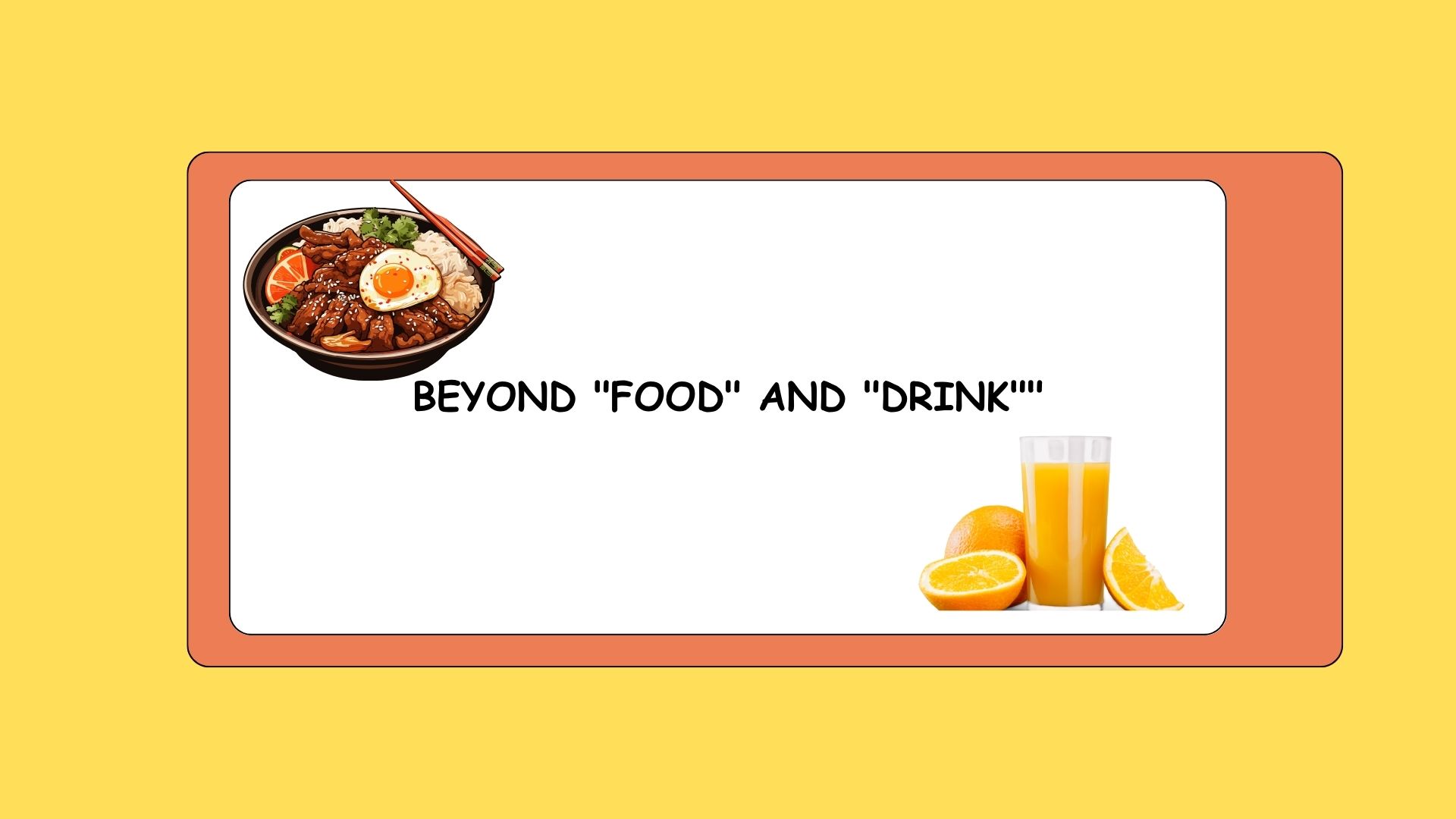
Learning English often starts with basic vocabulary like “food” and “drink.” However, to truly master the language and discuss culinary experiences with nuance, it’s essential to expand your knowledge of related terms. This article will explore various words and phrases that describe eating, drinking, and different types of sustenance, providing a comprehensive guide for English learners. Whether you’re a beginner or an advanced speaker, understanding these alternatives will enrich your vocabulary and improve your ability to communicate effectively about all things culinary.
Table of Contents
- Introduction
- Defining “Food” and “Drink” More Broadly
- Structural Breakdown of Culinary Vocabulary
- Types and Categories of Food and Drink Terms
- Examples of Alternative Words for Food and Drink
- Usage Rules and Considerations
- Common Mistakes to Avoid
- Practice Exercises
- Advanced Topics in Culinary Vocabulary
- Frequently Asked Questions
- Conclusion
Defining “Food” and “Drink” More Broadly
The words “food” and “drink” are fundamental, but they represent a vast and diverse category. Food refers to any substance consumed to provide nutritional support for the body. This includes everything from simple snacks to elaborate meals. Drink, on the other hand, refers to any liquid intended for human consumption, primarily to quench thirst or provide hydration. These definitions are broad and encompass a wide range of items, but more specific vocabulary allows for a more precise and descriptive discussion of culinary matters.
Expanding beyond these basic terms involves understanding synonyms, related concepts, and different categories within the culinary world. For example, instead of simply saying “food,” one might use words like “sustenance,” “nourishment,” “cuisine,” or “provisions,” depending on the context. Similarly, “drink” can be replaced with “beverage,” “refreshment,” or even specific terms like “infusion” or “concoction.”
Structural Breakdown of Culinary Vocabulary
The structure of culinary vocabulary can be broken down into several key components: nouns (referring to specific foods and drinks), verbs (describing actions related to eating and drinking), adjectives (modifying the qualities of food and drink), and adverbs (describing how eating or drinking is done). Understanding these parts of speech is crucial for constructing grammatically correct and descriptive sentences.
For example, consider the sentence: “She savored the delicious pasta slowly.” Here, “pasta” is a noun representing the food, “savored” is a verb describing the act of eating, “delicious” is an adjective modifying the pasta, and “slowly” is an adverb describing how she ate it. By mastering the different parts of speech, you can create vivid and detailed descriptions of culinary experiences.
Types and Categories of Food and Drink Terms
Culinary vocabulary can be categorized in numerous ways, including by meal type, beverage type, cuisine, cooking method, and ingredients. Understanding these categories will help you organize your vocabulary and use the appropriate terms in different situations.
Meals
The term “meal” refers to a specific occasion when food is eaten. Different cultures and contexts have various names for these occasions. The most common meals are breakfast, lunch, and dinner, but there are also other terms like brunch, supper, and snacks.
Beverages
A “beverage” is any type of drink. This category includes water, juice, soda, coffee, tea, alcoholic drinks, and many other types of liquids consumed for hydration or enjoyment. Different beverages have different characteristics and are often associated with specific meals or occasions.
Cuisine Types
“Cuisine” refers to a style of cooking characterized by distinctive ingredients, techniques, and dishes, and is usually associated with a specific country or region. Examples include Italian cuisine, French cuisine, Chinese cuisine, and Mexican cuisine. Each cuisine has its own unique vocabulary and culinary traditions.
Cooking Methods
Cooking methods describe the techniques used to prepare food. These methods include baking, frying, grilling, boiling, steaming, and roasting. Each method affects the texture, flavor, and nutritional content of the food. Understanding these terms allows you to discuss how food is prepared.
Ingredients
“Ingredients” are the individual components that make up a dish. These can include vegetables, fruits, meats, spices, herbs, and dairy products. Knowing the names of different ingredients is essential for understanding recipes and discussing food in detail.
Eating Styles
Eating styles refer to the manner in which food is consumed. This can include formal dining, casual eating, snacking, or grazing. Different eating styles are associated with different social contexts and cultural norms.
Examples of Alternative Words for Food and Drink
To illustrate the richness of culinary vocabulary, here are several examples organized by category. These examples will help you expand your vocabulary and use more precise and descriptive language when discussing food and drink.
Examples Related to Meals
Instead of always using “breakfast,” “lunch,” and “dinner,” consider these alternatives. The following table provides examples of sentences using different terms related to meals and eating times. Understanding these terms enhances your ability to describe different eating habits and social contexts.
| Alternative Term | Example Sentence |
|---|---|
| Breakfast | I usually have cereal for breakfast. |
| Lunch | We’re going out for lunch today. |
| Dinner | What are we having for dinner? |
| Brunch | Let’s meet for brunch on Sunday morning. |
| Supper | In our family, we always called the evening meal supper. |
| Snack | I need a quick snack to hold me over until dinner. |
| Refreshments | Light refreshments will be served after the meeting. |
| Fare | The restaurant offers a wide variety of delicious fare. |
| Repast | The wedding repast was a lavish affair. |
| Nourishment | After the long hike, we needed some serious nourishment. |
| Provisions | We packed plenty of provisions for our camping trip. |
| Sustenance | During the famine, finding sustenance was a daily struggle. |
| Victuals | The wagon was loaded with victuals for the journey. |
| Grub | Let’s grab some grub before the movie starts. |
| Eats | The party will have plenty of good eats. |
| Mealtime | Mealtime is a special occasion for our family. |
| Refreshment break | We took a refreshment break during the conference. |
| Feeding | The baby needs her feeding every three hours. |
| Bite | Let’s get a quick bite to eat. |
| Course | The main course was a delicious roasted chicken. |
| Spread | The picnic spread included sandwiches, salads, and desserts. |
| Potluck | We’re having a potluck dinner this weekend. |
| Tapas | We enjoyed some delicious tapas at the Spanish restaurant. |
| Appetizers | The appetizers included mini quiches and spring rolls. |
| Hors d’oeuvres | The hors d’oeuvres were beautifully presented at the gala. |
| Entree | The entree was served promptly after the appetizers. |
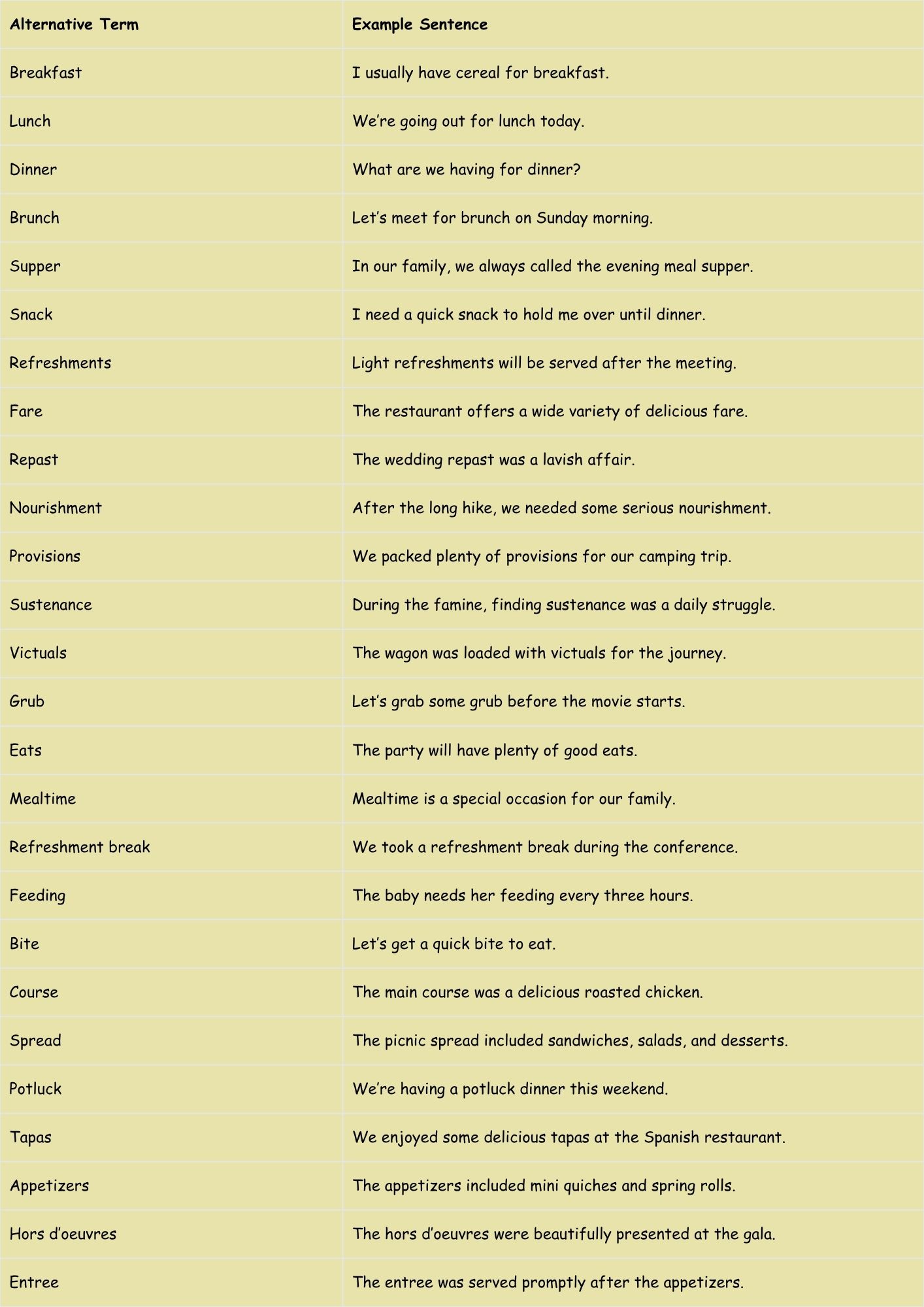
Examples Related to Beverages
Instead of simply saying “drink,” consider the wide range of alternatives that exist. The following table provides examples of sentences using different terms related to beverages. Using these terms adds depth and detail to your descriptions of what people drink.
| Alternative Term | Example Sentence |
|---|---|
| Beverage | What kind of beverage would you like with your meal? |
| Drink | Can I get you a drink? |
| Refreshment | We offer a variety of cold refreshments. |
| Potion | The wizard brewed a mysterious potion. |
| Elixir | The old woman claimed the tea was an elixir for good health. |
| Concoction | He created a strange concoction of fruit juices and spices. |
| Infusion | Herbal infusions can be very soothing. |
| Brew | The coffee shop is known for its special brew. |
| Libation | The party featured a wide selection of alcoholic libations. |
| Draught | He ordered a draught of beer at the pub. |
| Swig | She took a quick swig of water after her run. |
| Gulp | He took a large gulp of soda to quench his thirst. |
| Sip | She took a delicate sip of her tea. |
| Quaff | He quaffed the entire glass of juice in one go. |
| Tippling | He enjoys a little tippling of wine in the evenings. |
| Wash | I need something to wash down this spicy food. |
| Fluid | It’s important to replenish your fluids after exercising. |
| Liquid | This medicine comes in liquid form. |
| Juice | I prefer orange juice with my breakfast. |
| Soda | He ordered a soda at the diner. |
| Tea | Would you like a cup of tea? |
| Coffee | I need a strong cup of coffee to wake up. |
| Wine | We enjoyed a bottle of red wine with our dinner. |
| Beer | He ordered a pint of beer at the pub. |
| Spirit | Whiskey is a strong spirit. |
| Cocktail | She ordered a fancy cocktail at the bar. |
Examples Related to Cuisine
Describing the type of cuisine can go beyond just naming the country of origin. The following table provides examples of sentences using different terms related to cuisine. These examples showcase how to describe specific dishes and culinary styles.
| Alternative Term | Example Sentence |
|---|---|
| Cuisine | Italian cuisine is known for its pasta and pizza. |
| Dish | Pasta carbonara is a classic Italian dish. |
| Fare | The restaurant offers American fare with a modern twist. |
| Delicacy | Caviar is considered a delicacy. |
| Specialty | Paella is a Spanish specialty. |
| Staple | Rice is a staple food in many Asian countries. |
| Culinary arts | He is studying culinary arts at a prestigious school. |
| Gastronomy | The book explores the history of French gastronomy. |
| Haute cuisine | The restaurant is known for its haute cuisine. |
| Fusion cuisine | The chef specializes in fusion cuisine that blends Asian and European flavors. |
| Ethnic food | We tried some delicious ethnic food at the festival. |
| Comfort food | Mac and cheese is the ultimate comfort food. |
| Street food | Bangkok is famous for its amazing street food. |
| Vegan cuisine | The restaurant offers a wide variety of vegan cuisine. |
| Vegetarian cuisine | The menu includes many delicious vegetarian cuisine options. |
| Regional cuisine | Each region of Italy has its own unique regional cuisine. |
| Local fare | We enjoyed some delicious local fare at the farmer’s market. |
| Traditional dishes | The restaurant serves traditional dishes passed down through generations. |
| Savory dishes | They offered a variety of savory dishes during the tasting. |
| Sweet dishes | The dessert menu was full of tempting sweet dishes. |
| Entrees | The entrees were beautifully plated and tasted amazing. |
| Side dishes | We ordered several side dishes to complement our meal. |
| Main course | The main course was a perfectly cooked steak. |
| Culinary traditions | The family follows many culinary traditions during the holidays. |
| Food culture | The documentary explores the vibrant food culture of Mexico. |
Examples Related to Cooking Methods
Instead of just saying “cooked,” describe *how* the food was prepared. The following table provides examples of sentences using different terms related to cooking methods. These terms allow you to discuss the techniques used to prepare different dishes.
| Alternative Term | Example Sentence |
|---|---|
| Baking | She enjoys baking cookies on the weekends. |
| Frying | He’s frying some chicken for dinner. |
| Grilling | We’re grilling burgers in the backyard. |
| Boiling | She’s boiling water for pasta. |
| Steaming | Steaming vegetables is a healthy way to cook them. |
| Roasting | We’re roasting a chicken for Sunday dinner. |
| Sautéing | She’s sautéing onions and garlic in olive oil. |
| Simmering | The sauce is simmering on the stove. |
| Poaching | He’s poaching an egg for breakfast. |
| Braising | We’re braising the beef for a stew. |
| Broiling | He’s broiling the steak in the oven. |
| Stewing | She’s stewing the vegetables in a rich broth. |
| Griddling | He’s griddling pancakes for the kids. |
| Deep-frying | They’re deep-frying the french fries. |
| Pan-frying | She’s pan-frying the fish fillets. |
| Sous vide | The chef is using the sous vide method to cook the meat. |
| Smoking | He’s smoking the ribs in the backyard. |
| Curing | They’re curing the meat to preserve it. |
| Pickling | She’s pickling cucumbers for the winter. |
| Fermenting | They’re fermenting cabbage to make sauerkraut. |
| Preparing | He is preparing dinner for his family. |
| Culinary preparation | This dish requires a lot of culinary preparation. |
| Food preparation | She is skilled in all aspects of food preparation. |
Examples Related to Ingredients
Instead of just saying “food,” be specific about the ingredients used. The following table provides examples of sentences using different terms related to ingredients. These terms enhance your ability to discuss the composition of different dishes.
| Alternative Term | Example Sentence |
|---|---|
| Ingredients | This recipe requires only a few simple ingredients. |
| Produce | The farmer’s market has a wide selection of fresh produce. |
| Grains | Rice, wheat, and corn are common grains. |
| Legumes | Beans and lentils are healthy legumes. |
| Dairy | Milk, cheese, and yogurt are dairy products. |
| Spices | Cinnamon, cumin, and paprika are common spices. |
| Herbs | Basil, oregano, and thyme are popular herbs. |
| Seasonings | Salt and pepper are essential seasonings. |
| Condiments | Ketchup, mustard, and mayonnaise are common condiments. |
| Additives | Some processed foods contain artificial additives. |
| Components | The dish has several delicious components. |
| Elements | The chef carefully selects the elements of each dish. |
| Vegetables | We need to buy more vegetables for the salad. |
| Fruits | She enjoys eating fresh fruits for breakfast. |
| Meat | What kind of meat do you prefer? |
| Poultry | Chicken and turkey are types of poultry. |
| Seafood | The restaurant specializes in fresh seafood. |
| Nuts | Almonds and walnuts are healthy nuts. |
| Seeds | Chia and flax seeds are nutritious additions to any meal. |
| Oils | Olive oil and coconut oil are healthy cooking oils. |
| Fats | Butter and lard are types of animal fats. |
| Sweeteners | Honey and sugar are common sweeteners. |
| Garnishes | The dish was decorated with edible garnishes. |
| Essentials | These are the essentials you need to make a cake. |
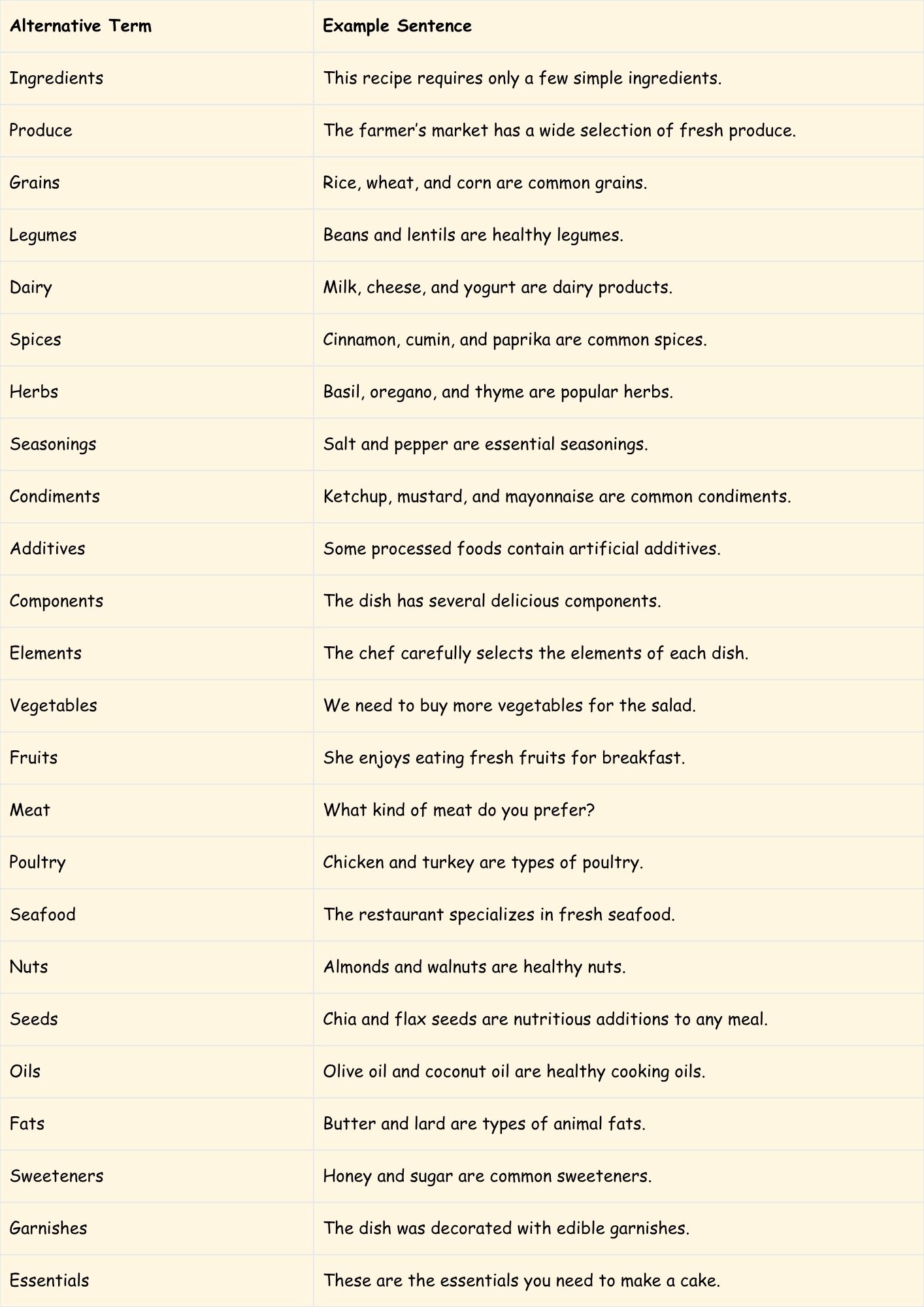
Usage Rules and Considerations
When using alternative words for food and drink, it’s important to consider the context and intended meaning. Some terms are more formal than others, while some are specific to certain regions or cultures. For example, “supper” is often used in the UK and some parts of the US to refer to the evening meal, while “dinner” is more common in other regions.
Additionally, be mindful of the connotations associated with different words. “Grub,” for instance, is a more informal and casual term for food, while “repast” is more formal and often used in literary contexts. Choose words that are appropriate for the situation and audience.
Common Mistakes to Avoid
One common mistake is using overly formal language in informal settings, or vice versa. For example, saying “I require sustenance” at a casual lunch with friends would sound unnatural. Another mistake is using regional terms that are not widely understood. Here are some examples of common mistakes with corrections:
| Incorrect | Correct | Explanation |
|---|---|---|
| “I ingest nourishment frequently.” | “I eat often.” | “Ingest nourishment” is overly formal. |
| “Let’s have some victuals.” | “Let’s have some food.” | “Victuals” is an archaic term not commonly used. |
| “I’m going to quaff some water.” | “I’m going to drink some water.” | “Quaff” implies drinking quickly and copiously, which may not be the intention. |
| “The repast was delicious, mate!” | “The dinner was delicious, mate!” | “Repast” is too formal for a casual conversation. |
| “I need some sustenance, innit?” | “I need some food, right?” | “Sustenance” is formal, and “innit” is a British slang that may not be understood. |
Practice Exercises
Test your understanding of alternative words for food and drink with these exercises. Choose the best word or phrase to complete each sentence.
Exercise 1: Fill in the Blanks
Choose the best word from the list to complete each sentence: cuisine, beverage, snack, sustenance, victuals
| Question | Answer |
|---|---|
| 1. After the long hike, we needed some __________. | sustenance |
| 2. What kind of __________ would you like with your meal? | beverage |
| 3. I need a quick __________ to hold me over until dinner. | snack |
| 4. Italian __________ is known for its pasta and pizza. | cuisine |
| 5. The wagon was loaded with __________ for the journey. | victuals |
| 6. We enjoyed some local __________ at the farmer’s market. | fare |
| 7. This restaurant serves delicious __________ from around the world. | dishes |
| 8. Let’s get a quick __________ before the movie starts. | bite |
| 9. The wedding __________ was a lavish affair. | repast |
| 10. We need to pack plenty of __________ for our camping trip. | provisions |
Exercise 2: Multiple Choice
Choose the best alternative word for the underlined word in each sentence.
| Question | Answer |
|---|---|
| 1. We had a delicious meal at the new restaurant. (a) beverage (b) repast (c) drink | (b) repast |
| 2. I need a drink to quench my thirst. (a) sustenance (b) potion (c) refreshment | (c) refreshment |
| 3. She is studying cooking at a culinary school. (a) eating (b) gastronomy (c) feasting | (b) gastronomy |
| 4. They packed food for the picnic. (a) beverages (b) victuals (c) snacks | (b) victuals |
| 5. We enjoyed some delicious Mexican food. (a) cuisine (b) drinks (c) grub | (a) cuisine |
| 6. He is preparing a special dish for the party. (a) beverage (b) meal (c) concoction | (b) meal |
| 7. I prefer to have a light meal in the morning. (a) dinner (b) breakfast (c) supper | (b) breakfast |
| 8. Let’s grab some food before we go. (a) sustenance (b) eats (c) potions | (b) eats |
| 9. What’s your favorite type of food? (a) repast (b) cuisine (c) nourishment | (b) cuisine |
| 10. He took a quick drink of water. (a) gulp (b) meal (c) bite | (a) gulp |
Advanced Topics in Culinary Vocabulary
For advanced learners, exploring the etymology of culinary terms and their cultural significance can be rewarding. For instance, understanding the origins of words like “sandwich” or “macaroon” provides insight into their historical and cultural contexts. Additionally, studying the vocabulary related to specific cuisines, such as French or Italian, can significantly enhance your culinary knowledge.
Another advanced topic is the use of figurative language in describing food and drink. Metaphors, similes, and personification can add depth and creativity to your descriptions. For example, instead of saying “The soup was delicious,” you might say “The soup was a warm embrace on a cold day.”
Frequently Asked Questions
Here are some frequently asked questions about alternative words for food and drink:
- What is the difference between “supper” and “dinner”?
“Supper” and “dinner” both refer to the evening meal, but “supper” is more commonly used in the UK and some parts of the US, particularly in more traditional or rural areas. “Dinner” is more widely used and generally understood. - When should I use “cuisine” instead of “food”?
Use “cuisine” when you want to refer to a specific style of cooking associated with a particular region or culture. For example, you would say “Italian cuisine” or “French cuisine” rather than “Italian food” or “French food.” - What is the difference between “snack” and “refreshment”?
A “snack” is a small amount of food eaten between meals to satisfy hunger. “Refreshments” can include both food and drinks served to refresh or revitalize someone, often at events or meetings. - Is it appropriate to use slang terms like “grub” in formal settings?
No, slang terms like “grub” are informal and should be avoided in formal settings. Use more formal terms like “food,” “meal,” or “sustenance” instead. - What are some formal alternatives to the word “drink”?
Formal alternatives to “drink” include “beverage,” “libation” (often used for alcoholic drinks), and “refreshment.” - How can I improve my culinary vocabulary?
Read cookbooks, watch cooking shows, and try new recipes. Pay attention to the words used to describe ingredients, cooking methods, and flavors. Don’t be afraid to look up unfamiliar terms. - What is the difference between “ingredients” and “components”?
“Ingredients” refers to the individual items that go into a dish, such as flour, sugar, and eggs. “Components” can refer to larger parts of a dish that are made up of multiple ingredients, such as a sauce or a filling. - How can I use adjectives to describe food more effectively?
Use descriptive adjectives that appeal to the senses, such as “savory,” “sweet,” “spicy,” “tangy,” “creamy,” “crispy,” and “aromatic.” Be specific about the flavors and textures you are describing.
Conclusion
Expanding your vocabulary beyond basic terms like “food” and “drink” is essential for effective communication about culinary experiences. By understanding the nuances of different words and phrases, you can describe meals, beverages, cuisines, and cooking methods with greater precision and detail. This article has provided a comprehensive overview of alternative words for food and drink, along with examples, usage rules, and practice exercises to help you master this aspect of English vocabulary.
Remember to consider the context and audience when choosing your words, and don’t be afraid to experiment with new terms. By continuously expanding your culinary vocabulary, you’ll improve your ability to discuss food and drink in a more engaging and informative way. So, go ahead, explore the world of culinary language, and savor the richness it has to offer!


